More Than Just Ethnic Artists
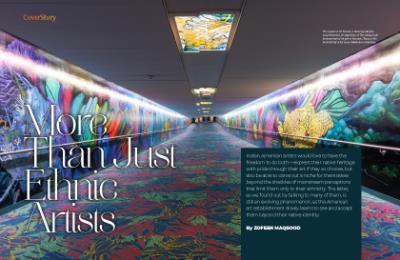
Indian American artists would love to have the freedom to do both—express their native heritage with pride through their art if they so choose, but also be able to carve out a niche for themselves beyond the shackles of mainstream perceptions that limit them only to their ethnicity. The latter, as we found out by talking to many of them, is still an evolving phenomenon, as the American art establishment slowly learns to see and accept them beyond their native identity.
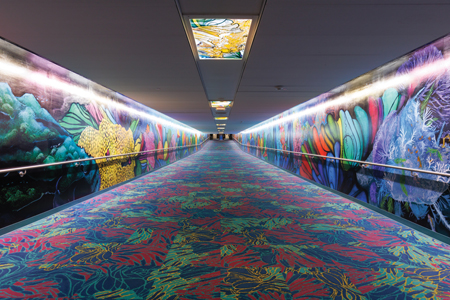
The Aquarius Art Tunnel, a stunning 240-footlong immersive art experience at The George Bush Intercontinental Airport in Houston, Texas, is the brainchild of artist Janavi Mahimtura Folmsbee.
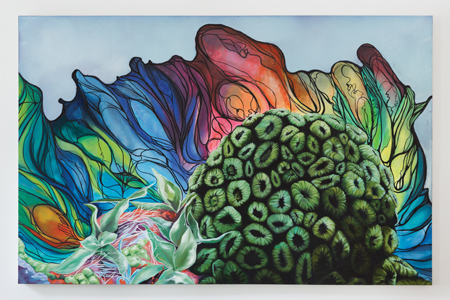 The George Bush Intercontinental Airport in Houston, Texas, has been consistently voted amongst the best in the U.S. It is also one of the busiest in the country with monthly foot traffic of about 22 million. Earlier this year, the airport unveiled the Aquarius Art Tunnel, a 240-foot-long stunning spectacle depicting marine life in all its vibrant colors.
The George Bush Intercontinental Airport in Houston, Texas, has been consistently voted amongst the best in the U.S. It is also one of the busiest in the country with monthly foot traffic of about 22 million. Earlier this year, the airport unveiled the Aquarius Art Tunnel, a 240-foot-long stunning spectacle depicting marine life in all its vibrant colors.
[Left] A section of The Aquarius Art Tunnel.
Situated between terminals D and E, two giant nine-foot-tall fine art murals greet you to this one-of-its-kind audio-visual experience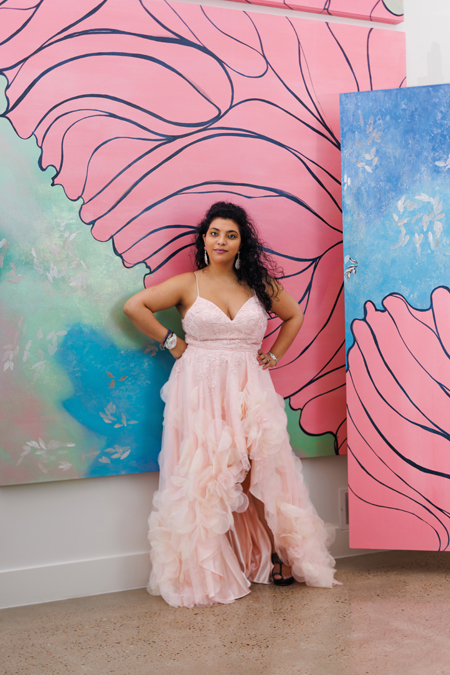 that includes classical music as well as soothing sounds of meditative, underwater breath. Almost 700 yards of custom-designed images of coral, sharks, dolphins, barracudas, lobsters, manta rays, along with a ceiling that features 15 unique lenticular works of art, create an immersive experience that is bound to surprise and captivate visitors. Recently, UNESCO endorsed the Aquarius Art Tunnel as a site for its scientific and educational importance towards ocean conservation through artistic outreach as an immersive art installation.
that includes classical music as well as soothing sounds of meditative, underwater breath. Almost 700 yards of custom-designed images of coral, sharks, dolphins, barracudas, lobsters, manta rays, along with a ceiling that features 15 unique lenticular works of art, create an immersive experience that is bound to surprise and captivate visitors. Recently, UNESCO endorsed the Aquarius Art Tunnel as a site for its scientific and educational importance towards ocean conservation through artistic outreach as an immersive art installation.
The brainchild behind this art experience is Indian American artist Janavi Mahimtura Folmsbee.
A Houston resident, Mahimtura Folmsbee, got selected for this project out of hundreds of applicants. From the initial Request for Qualification (RFQ) process to shortlisting and making it to the final panel, it took over a year for her to finally bag the project. The artist says that she persevered because she knew that a project of this scale by a woman and an Indian-origin artist would hold a great significance for people of color across America.
[Right] Janavi Mahimtura Folmsbee.
A few standout examples of the influence of Indians on the American Art landscape
Mahimtura Folmsbee belongs to a newer generation of artists who may be redefining what art by Indian Americans looks like in America. Mumbai-born Anish Kapoor’s sculpture, “Cloud Gate,” colloquially popular as the “The Bean,” remains a Chicago landmark. Since September of last year, visitors to New York’s Central Park are greeted to an 18-foot-tall bronze statue reminiscent of an Indian goddess with 24 heads. The sculpture titled, “Ancestor,” is created by Indian-origin artist Bharti Kher.
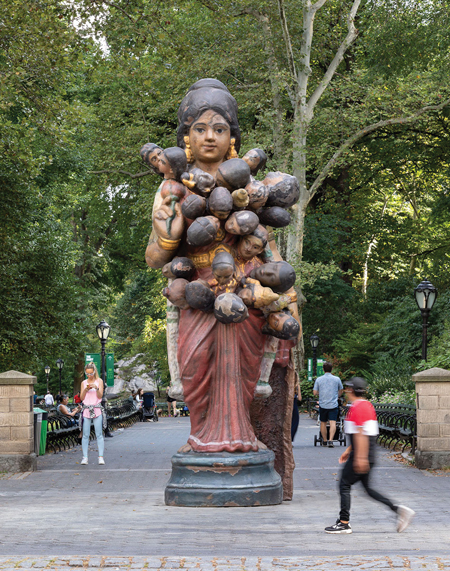
Despite these excellent examples of crossover art by established artists, many Indian artists in America feel that there remains a paucity of platforms as well as a lack of commitment from curators, investors, as well as gallerists towards promoting Indian American artists. Mahimtura Folmsbee, along with many of her contemporaries, feel a need for dialogue amongst the diaspora about a lack of mainstream representation of Indian American artists.
[Left] “Ancestor,” an 18-foot-tall bronze statue reminiscent of an Indian goddess with 24 heads, designed by Bharti Kher, greets visitors to New York’s Central Park.
Representation deficit
Alabama-based artist Amita Bhakta, who is on the Board of Directors at the Tennessee Valley Art Association, has been showcasing her work at many places including the Kennedy-Douglass Centre for the Arts in Florence, Alabama. She believes, “There is a huge deficit in the investment for our cultural sector. There is also a lack of recognition for Indian American art.” She feels that the graph of progress of Indian artists in America pales in comparison to other immigrant communities.
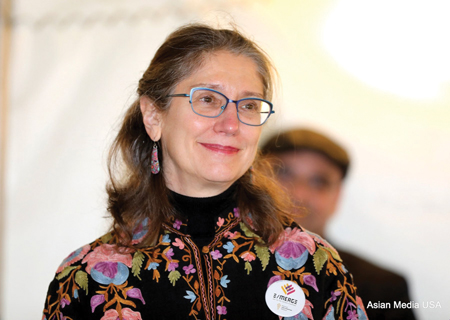
Bhakta points out that the National Indo-American Museum (NIAM) in Chicago, the first of its kind, opened just a year ago. “We just made our first small start, while in contrast, the Chinese American and Pacific Asian American communities have built more than 29 museums to preserve their cultural heritage on U.S. soil. By 2025, there will be a large, beautiful museum honoring Chinese heritage at the cost of a hundred and eighty million dollars in New York.”
[Right] “To our knowledge, NIAM is the only museum in the U.S. dedicated to the Indian American story.”—Tamara Biggs, executive director of the National Indo-American Museum (NIAM) in Chicago.
The National Indo-American Museum (NIAM) definitely bridges a gap that artists often feel when it comes to showcasing their work against a backdrop that best represents their cultural identities while understanding the off- shoot that Indian art has also taken in America.
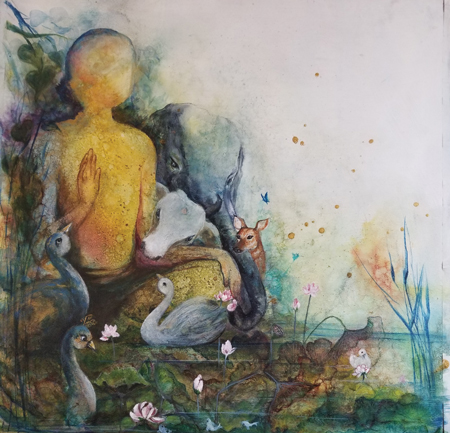
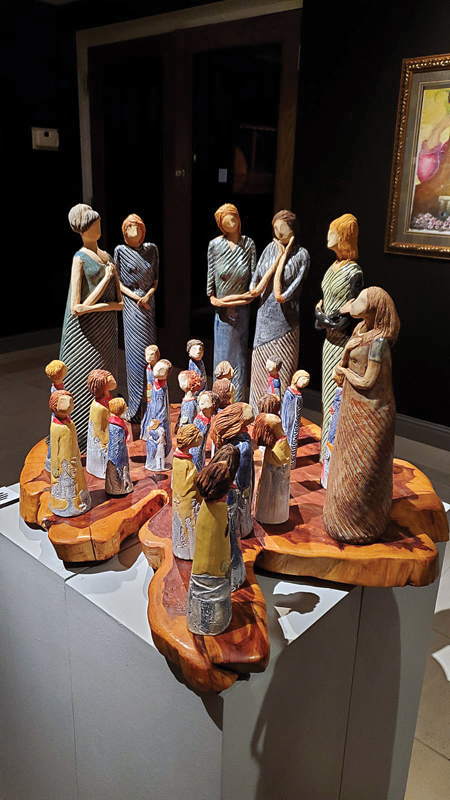
Amita Bhakta, who is on the Board of Directors at the Tennessee Valley Art Association, along with her works: “The Awakened One,” with inks and acrylics, and “Circle of Love.”
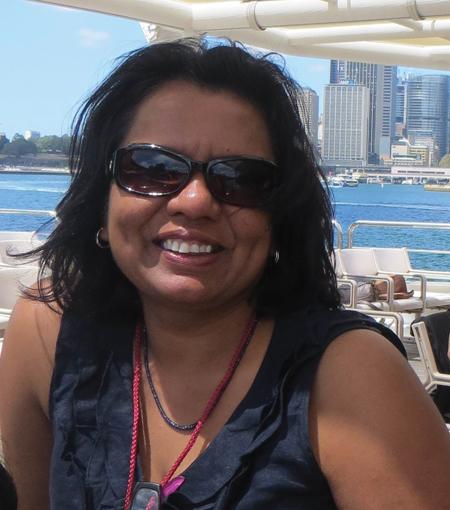
In an attempt to showcase the wonderful contrast that modern-day Indian artists are creating, the NIAM, during its opening in 2021, hosted a modern art exhibition, titled “E/Merge: Art of the Indian Diaspora,” featuring nine modern Indian American artists working from coast to coast. Tamara Biggs, executive director of NIAM believed that opening the museum with something groundbreaking and unexpected was important. The NEA liked her proposal and awarded $20,000 towards the project. “To our knowledge, NIAM is the only museum in the U.S. dedicated to the Indian American story.”
Indian-origin artists stress that although, while exploring to showcase their works, they do not necessarily look for an Indian curator or a gallerist, sometimes their absence is too obvious to ignore. Artist Mahimtura Folmsbee says, “I live in Texas, a state with the second-largest Indian American population and I have yet to find an Indian-origin gallerist. That does say something.”
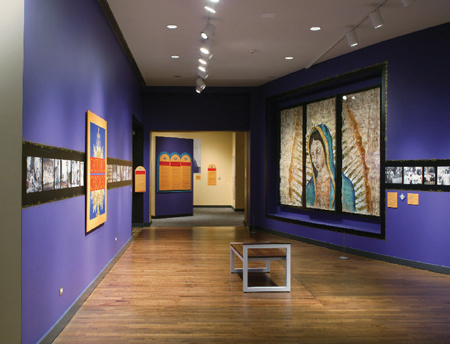
The NIAM bridges a gap that Indian artists often feel when it comes to showcasing their work against a backdrop that best represents their cultural identities while also understanding the offshoot that Indian art has taken in America.
Expectation versus reality
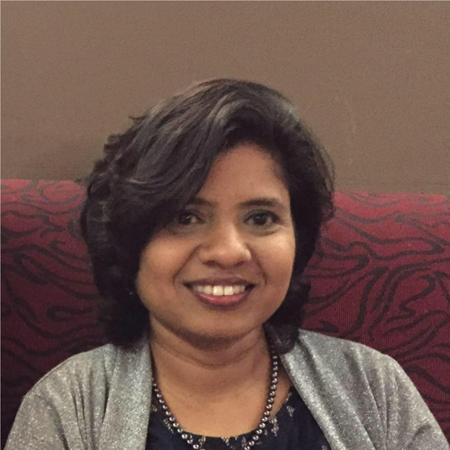 In January of 2021, just ahead of Donald Trump’s ouster from the White House, Sujata Tibrewala created a painting titled, “Bloody Immigrant,” which showed Deb Haaland, the first-ever Native American politician and cabinet secretary, kneeling over Trump. It sought to make a statement about the killing of African American George Floyd by an American policeman. “My painting paid a tribute to five million Native Americans and their history in America.” However, it came as a surprise to her that many Indians questioned her choice of taking on colonialism, black rights, American history of coercion, and the infamous “trail of tears” (a forced displacement of over 60,000 people between 1830 and 1850 by the U.S. government)”
In January of 2021, just ahead of Donald Trump’s ouster from the White House, Sujata Tibrewala created a painting titled, “Bloody Immigrant,” which showed Deb Haaland, the first-ever Native American politician and cabinet secretary, kneeling over Trump. It sought to make a statement about the killing of African American George Floyd by an American policeman. “My painting paid a tribute to five million Native Americans and their history in America.” However, it came as a surprise to her that many Indians questioned her choice of taking on colonialism, black rights, American history of coercion, and the infamous “trail of tears” (a forced displacement of over 60,000 people between 1830 and 1850 by the U.S. government)”
In 2020, during the middle of the pandemic, artist Sujata Tibrewala took matters into her own hands to promote minority representation through art. She conceived a project to create a life-size mural in her neighborhood school in Milpitas, California, so that children of the school would have role models to look up to from their respective minority communities.
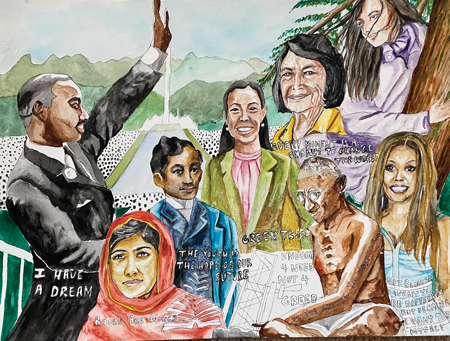
“As a woman artist of color in America, one is anyway dealing with systemic biases every day. But what is especially hurtful is when the pushback comes from familiar quarters. Some commented that they could not grasp why my work had Native American or African American themes. While I do create Sri Yantras and Mandalas, I fail to understand why it is still expected that Indian-origin artists should only create art reflecting their roots. Art is a global language and we need to get Indian art out of its pre-conceived notions,” Tiberwala explains.
An Indian-origin artist, on condition of anonymity, confirmed to us that they lost a major grant because they described their works as reflective of global affairs while the judges expected their work to be rooted in Indian history and tradition.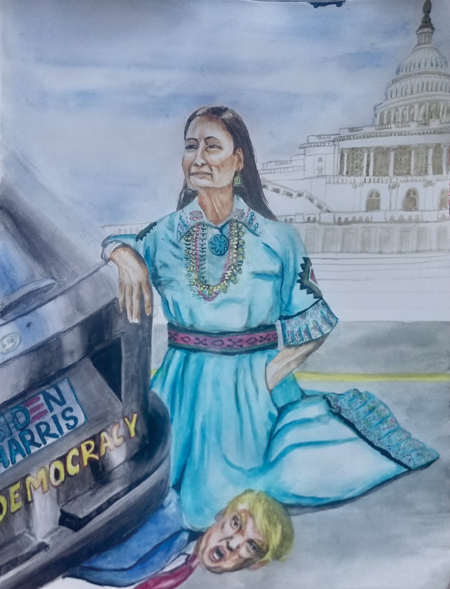
[Right] Tibrewala found it disappointing that her own Indian community questioned her relevance and credentials for painting, “Bloody Immigrant,” which showed Deb Haaland, the first-ever Native American politician and cabinet secretary, kneeling over Trump.
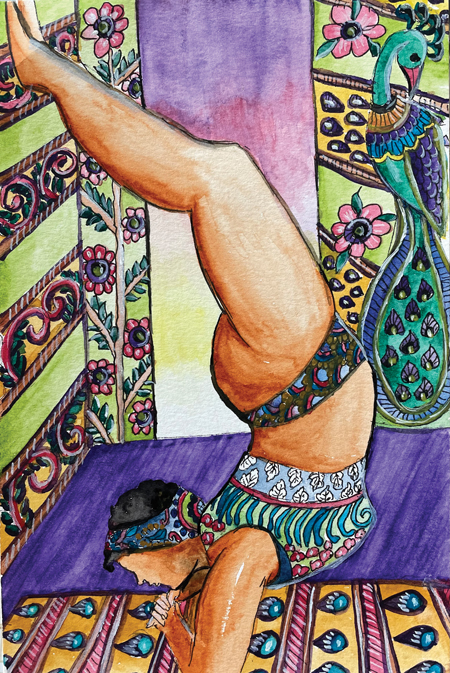
[Left] To challenge the whitewashed notions that box Indian artists into stereotypes, Tibrewala showcased “Curvy Yoga,” a series of work at the Tahoe Art League. “I showed Indian princesses in ethnic wear practicing yoga. I also showed curvy women confident in their plus-size bodies performing asanas,” she says.
Contemporary artist Avantika Bawa, who is on the board of the Oregon Arts Commission, says, “It would be easier if I were to cater to the curators and audience who seek this sort of tokenism. Instead, I aim to create work that is formal and beyond space and time. Interestingly, when curators can’t place me in any sort of preconceived canon or -ism, confusion occurs. Some curators embrace this as refreshing while others just walk away confused or disinterested in the work [of an ethnic artist] making a statement on issues like identity, politics, or mainstream culture.”
Bawa, who also teaches fine arts at Washington State University, has worked on a series of installations that showcase linear, functional art—something, she admits, many gallerists are surprised to see coming from an Indian-origin artist. However, expression, for most artists, does not follow a restrictive pattern. So, while for an art installation in India’s Rann of Kutch, Bawa chose a pink scaffold highlighting the beauty of the salt desert, for her exhibit in Chicago, her work titled, “The Pinkest Pink,” was a nod to the vibrancy of India without having too many elements to it.
Mahimtura Folmsbee sometimes sees humor in the way Indian artists are expected to showcase their culture through their works. She says, “My work is a bridge between science and art, and a lot of it shines a light on an essential natural resource—marine life. It confuses curators or gallerists who expect my work to be more ‘Indian.’ I mean, I am a maximalist artist, my color palette is vibrant, the clothes I wear to art openings are Bollywood-inspired, and my work predominantly features water because I grew up seeing the ocean in Mumbai. Even sea fan coral reefs depicted in my art are a variety found off Mumbai’s coastline. Ironically my work couldn’t be more Indian if one pays attention.”
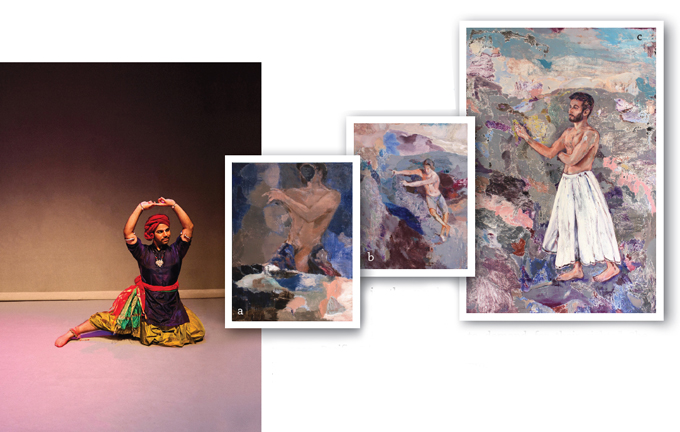
[Left] “Art of Indian diaspora is still lacking national-level attention. As South Asians, we need to support our own artists in the U.S.,” says artist Kuldip Singh. (Photo: Steni Stephan)
Singh’s paintings:
a. “Mountain Maker in Raag,” oil on linen.
b. “Moon Sickle in Des Raga,” oil on canvas
c. “Hamza in Shri Raag,” oil on canvas
Lack of understanding of contemporary Indian art
New York-based multidisciplinary artist Kuldeep Singh, who recently got the Wyckoff Milliman Grant Award at the University of Washington in Seattle, observes, “Indian art in museums in the U.S. is mostly about historical objects. It has not yet emerged as an art practice of contemporary artists adding to the cultural voice of Indians living in the U.S. in our times.”
Some artists are also actively campaigning through their art to challenge the whitewashed notions that box Indian artists into stereotypes. Sujata Tibrewala showcased a series of works titled, “Curvy Yoga,” at the Tahoe Art League some time back. She says, “I showed Indian princesses in ethnic wear practicing yoga. I also showed curvy women confident in their plus-size bodies performing asanas. This was important because when the West took Yoga, they totally whitewashed it. Today yoga is synonymous with lean women in Western wear, hopping to yoga studios. While it is okay to adopt a positive discipline from another culture, the real history of it should not be diluted. Yoga originated in ancient India where the princesses practiced it too —in their Indian outfits. Ancient paintings depict women of all shapes and sizes flexibly performing asanas. That, to me, is the body-positive message we need. I wanted to highlight that lost history of yoga, not just the version the West wants to see!”
Looking inwards
New York-based multidisciplinary artist Kuldeep Singh, whose solo exhibitions combining poetry, music, and dance, along with his paintings at spaces such as Ortega y Gasset Projects (OyG), have received reviews. He says, “Art of Indian diaspora is still lacking national-level attention. As South Asians, we need to support our own artists in the U.S.” He believes there is a lack of support network towards the artists because the Indian community does not value art as a professional endeavor. “This is a huge mistake—because art shapes the overall identity of a community and provides a framework for it. Especially in the U.S. where diversity and immigrants matter.”
Sujata Tibrewala says, “Typically, when an artist is starting out, they are supported by their own community. But sadly, the Indian community still does not want to invest in promoting its artists. My American students and buyers value art more. This reflects the lack of encouragement Indian kids get to pursue art during childhood. We don’t have a culture of respecting artists. None of us know the names of artists behind the excellent paintings at Ajanta or those behind sculptures in our temples, while Michelangelo is famous around the world as the artist of the Sistine Chapel.”
Artist Kuldeep Singh says, “The American mainstream has started recognizing a handful of artists, say, in the field of dance or music. There is still a lack of proper recognition of visual arts. It needs a catalytic push so that it can evolve with the Indian community. That is what would sustain the artists who are committed to their form.”
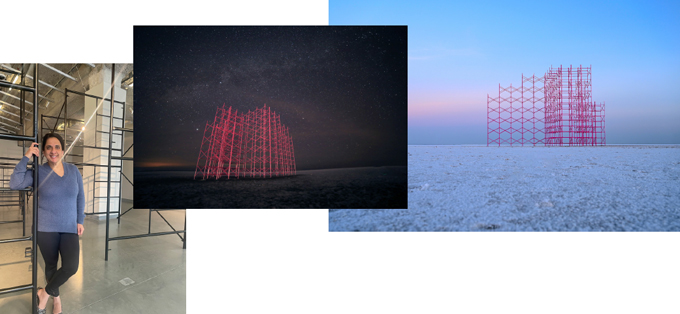
Contemporary artist Avantika Bawa’s “Pink Scaffold,” a sphinx-like art installation that rises above the horizon of the Rann of Kutch.
Taking charge and making an impact in American communities through art
Some artists are taking it upon themselves to create representation through art. In 2020, during the middle of the pandemic, artist Sujata Tibrewala proposed a project to her neighborhood school in Milpitas, California, about creating a life-size mural for kids to seek inspiration.
She says, “Milpitas, a city in Santa Clara County, is a hub of information technology companies and has grown into a very diverse place. The majority of students in the nearby schools came from Hispanic, Indian, Vietnamese, Pacific Islander, and Native American communities. There has been a gap in representation in mainstream America, especially for these kids. So, I thought of painting a life-size mural in school featuring role models of color that can be a source of inspiration to the young kids.”
She, along with Sabrina Davidson, a visual artist from San Diego State University, wrote to the school authorities and engaged the kids to create a mural that speaks to them. Along with the school, they decided to narrow down what kids chose and came up with a list. The final mural saw pictures of Mahatma Gandhi; Nobel Prize laureate Malala Yousufzai; Cao Vinh Thinh, an environmental activist from Vietnam; American civil rights activist Dolores Heurta; and Julia Butterfly Hill, co-founder of the Circle of Life Foundation and committed to transforming human interactions with nature; and many others.
Tibrewala says, “Unless kids are shown that people like them continue to make the world a better place, they will not be inspired to demand for their rights.” She adds, “I think it’s the same organic process in art too. Unless we Indian artists assert ourselves—show our craft, both ethnic and mainstream— perhaps our work won’t get the attention it deserves.”
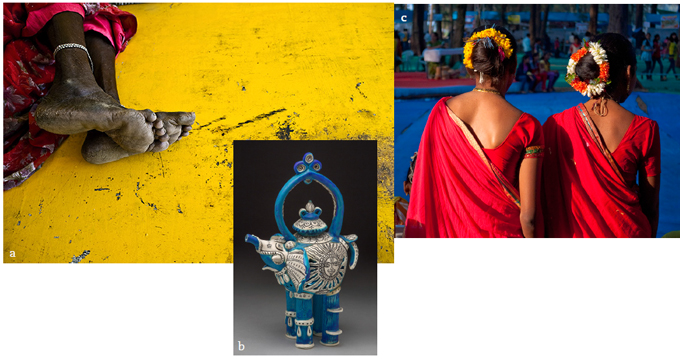
Photos from “Darshan: Visions of India” exhibit at the Tennessee Valley Art Association in Tuscumbia, Alabama.
a. “Tired as Yellow” - (Artist/photo: Nikkita Bhakta)
b. Ms. Gaji - (Artist: Tripti Yoganathan)
c. Varli Dancers - (Artist/photo: Neha Luhar-Trice)
Optimism around the corner
Some art experts also point out that it may be early to expect many changes. Mahimtura Folmsbee says, “I studied at the Art Institute of Chicago in 2008. The shift from a focus on fine arts to public art was still developing, The Bean, had just been installed in 2004. But it is only in the last three years that public art has really boomed. So, there is still a lot of scope for Indian artists in the mainstream.”
Things might just be looking up too for Indian American representation in the visual arts. In the summer of 2022, one of the country’s biggest museums, the Dallas Museum of Art in Texas, named Gowri Sharma Natrajan as its new board president, making her the first person of color to chair the board in the institution’s 119- year history.
Biggs of says, “I think the stars are finally aligning for Indian American art. I know many U.S. collectors have purchased works by Indian artists working in India. The nine artists of “E/Merge,” even while bemoaning the lack of attention and cohesion among Indian American artists, also acknowledge that things are slowly changing. I believe that the rise of Indian Americans in popular culture—on TV, in movies, and in music—has had a ripple effect that helps artists garner some attention.”
Artist Janavi offers a realistic view when she says, “People often forget it is difficult, in general, to make it as an artist. The industry is competitive and highly subjective in nature. I have learned to only compete with myself and to keep going, no matter what.” As an artist of Indian origin making her presence felt in America, she says, “I believe in change, and I am happy to make that change happen by refusing to conform my work to any preconceived notion of what my art should look like.”
Zofeen Maqsood is a U.S. based journalist who writes extensively on millennial trends and expat issues. She has contributed for some of the biggest publications and websites in India and in the U.S.
“All minority artists have historically been shamefully overlooked or willfully avoided”
Curator JONATHAN CAIN of Tennessee Valley Art Association in Tuscumbia, Alabama, was instrumental in the Association’s decision to present the art exhibit “Darshan: Visions of India.” In an interview, Cain talks about minority representation in American art.
As a curator, what are your perceptions about art by Indian artists?
I think that at any time when we, as consumers of art, are allowed to view work from a different viewpoint, it enriches our lives and brings new perspectives. Having the privilege of speaking with many of the artists involved in our “Darshan: Visions of India” exhibit allowed me to appreciate their work and gain an understanding of their viewpoints.
Do you see many Indian-origin artists in the art circles today?
That depends largely on the community and the forward-thinking art and cultural institutions in it. Our area of northwest Alabama does not have a large Indian community. My initial connection to the Indian community started from one of our board members, Amita Bhakta, a very well-respected artist in the state. In a passing conversation with Amita, we floated the idea of offering an exhibit to explore Indian identity and celebrate the richness of Indian culture.
One of the highlights of our exhibit was the celebration of Holi. It brought a diverse group of people together to enjoy traditional music, dance, storytelling, and food. It sparked many meaningful conversations between Indians and non-Indians about religion, food, dress, traditions, etc. To date, it is the single most important event bringing about cultural awareness that I have had a part in at the Tennessee Valley Museum of Art.
Do you feel Indian artists are well-represented in the mainstream?
The short answer is that all minority artists have historically been shamefully overlooked or willfully avoided. Only recently, cultural institutions have been finally thinking in terms of decolonization. Museums are being required to examine their approaches, presentation, and ingrained historical biases.
During our Darshan exhibit, I was utterly shocked to be thanked so many times by the artists for offering them the opportunity to exhibit. The quality of the work and the diversity of artistic voices were amazing. I had no real idea of the lack of representation.
Because of the realization that these voices were not being heard, we are curating a traveling exhibition titled “Traveling Darshan,” which pulls from the original group of artists but also features new submissions from artists across the country. We are hoping to place it in its first venue early this Fall, and other locations will soon follow.
Do you feel art is bracketed based on where the artist is from, or where their inspirations are derived from? As a curator, do you think about such things while reviewing works of art?
The art world is facing the problem of overcoming the colonial mindsets that took root as Europeans looted cultural goods around the world. Institutions are now facing moral dilemmas of how to offer representations of cultures and civilizations with objects that they may not have the right to possess or should be exhibiting.
This gets particularly difficult when facing the issues of preservation of precious items that hold a significant cultural position or religious function. Our holding of culturally significant objects is limited to a small collection of Native American projectile points and a few other similar objects. As an institution, we have consciously made the correct decision to no longer accept such items into our permanent collection and strongly encourage others to do likewise.
What are your thoughts on the art scene from emerging countries?
My exposure to large numbers of avant-garde artists is limited. The center of the arts has continuously moved over time—first it was in Rome and Florence in Italy during the Renaissance; then Paris with the French Academy and the Impressionists in the 18th and 19th centuries; and New York during WWII through most of the twentieth century. Where is it now? Who knows. Perhaps, it has moved to Japan, India, China. We are too close to the movement to be able to clearly see it but in the years to come, it will emerge.
Why do you think immigrant artists find it tough to get noticed in the U.S.?
I think most artists find it tough to be noticed. The gatekeeping institutions have limited space and perhaps interests that are too narrow. It has been my experience that artists need coaching on making connections, offering enticing proposals, and conducting business with artistic and cultural institutions. Every artist needs to refine their artist statement and know how to best present their work to directors, curators, etc.
Likewise, we, at cultural institutions, need to expand our understanding of their work when it is unfamiliar to us and learn to ask the right questions to assist us in properly presenting their works.
In my experience of curating “Darshan,” I was incredibly fortunate to have an energetic Indian community to help plan the events and to better understand the challenges of the exhibit by correcting my misunderstanding of artworks that explained religious imagery and culture. I was, and still am, extremely grateful for their patience. My knowledge from discussing the exhibited works offered me a mere glimpse into the diversity and sophistication of a culture I previously had limited knowledge of.
Enjoyed reading Khabar magazine? Subscribe to Khabar and get a full digital copy of this Indian-American community magazine.
blog comments powered by Disqus










